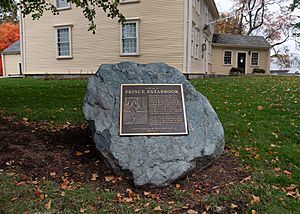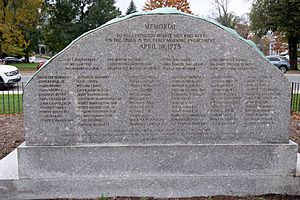Prince Estabrook facts for kids
Quick facts for kids
Prince Estabrook
|
|
|---|---|
| Born | 1741 |
| Died | 1830 (aged 88–89) Ashby, Massachusetts |
| Allegiance | United States |
| Service/ |
Massachusetts Militia |
| Years of service | 1775–1783 |
| Battles/wars | American Revolutionary War |
Prince Estabrook was a brave black man who was enslaved but fought for freedom. He was a Minutemen soldier, a type of volunteer soldier ready to fight at a moment's notice. He was wounded in the Battle of Lexington and Concord. This was the very first battle of the American Revolutionary War.
A paper from that time called him "a Negro Man." It spelled his name Easterbrooks and said he was among the injured from Lexington, Massachusetts. Prince Estabrook was born around 1741. He was enslaved by the Benjamin Estabrook family. He likely took his last name from them. After the war, he became a free man.
Contents
Prince Estabrook's Early Life
Prince Estabrook was an enslaved black man. He was owned by Benjamin Estabrook in Lexington. We don't know much about when or where Prince Estabrook was born. It's possible he was born into the Estabrook family home. He might have been the son of another enslaved person named Tony.
By 1775, there were only a few enslaved people in Lexington. Estimates say there were between five and 24. Slavery in New England was different from the South. Prince likely worked on the farm with Benjamin. He also helped with chores around the house. Some stories say Prince and Benjamin were friends. Prince even helped Benjamin sell horses.
The Battle of Lexington Green
Paul Revere rode into Lexington around midnight on April 19, 1775. Another rider, William Dawes, arrived about 30 minutes later. They were sent to warn the town of Concord. British soldiers were marching toward Concord. The riders stopped to talk with John Hancock and Sam Adams. They were staying nearby.
Soon after the riders left, Captain John Parker called his soldiers together. This was the Lexington militia. They met on the town common after 1 a.m. No British troops were in sight yet. So, the militia was told to go home. But they had to stay close enough to hear the drums if they were called back. Many went to Buckman Tavern. This was right across from Lexington Green.
Several hours later, the soldiers were called back. About 77 militia soldiers gathered on the green. They got ready to fight. About 700 British troops were coming. Prince Estabrook was among these brave soldiers. Even though laws might have stopped him from training, he answered the call.
Tension grew between the two groups. Then, a shot was fired. No one knows who fired the first shot even today. A fight followed. Eight militia soldiers died, and nine were hurt. Prince Estabrook was one of the injured. He was wounded in his left shoulder. Prince and others were taken to the Estabrook home. Dr. Joseph Fiske treated their injuries.
Fighting for Freedom: Prince's Army Service
Prince Estabrook got better from his injuries. He was back in action about two months later. This was during the Battle of Bunker Hill in June 1775. The soldiers from Lexington Company guarded the new Continental Army headquarters. This was in Cambridge, Massachusetts. Prince Estabrook was one of these guards.
Prince didn't have more military records until July 1776. Then, he joined Colonel Jonathan Reed's regiment. They went to Fort Ticonderoga. The American ships lost a battle on Lake Champlain. This was the Battle of Valcour Island. But the British never attacked the troops at Fort Ticonderoga. Prince's unit stayed there until November 30.
Estabrook was called to serve again the next year. From November 1777 to April 1778, he guarded British prisoners in Cambridge. In July 1780, Estabrook joined the army for six months. He left the army in April 1781. In June 1781, he joined again for three more years. Estabrook was part of the Massachusetts Third Regiment. He likely helped build forts in New York. This regiment was officially ended on November 3, 1783.
Becoming a Free Man
After the war, Prince Estabrook went back to Lexington. He was now a free man. People often say Benjamin gave Prince his freedom. But a court case called Quock Walker had already made slavery illegal in Massachusetts. This happened by the time Prince came home.
However Prince became free, he stayed with Benjamin's family. The 1790 census shows Benjamin Estabrook's home included a "non-white freeman." Prince likely worked for Benjamin as a paid farmhand. We don't know much about his life in the community. But some stories say people in town thought highly of him.
Some sources say Prince Estabrook got married. But there is no official record of a marriage.
Later Life and Legacy
Benjamin Estabrook died in 1803. After that, his family started to move away. His son, Nathan, moved to land in Ashby, Massachusetts in 1805. He sold the house in Lexington. Around this time, Prince moved to live with Nathan in Ashby. Prince would have been in his mid-sixties then.
Prince Estabrook died in 1830. He was thought to be about 90 years old. He was buried behind the Ashby Church. His grave simply said "Prince Estabrook, Negro." In 1930, the US War Department replaced his headstone. The new one recognized his service in the Revolutionary War. The town of Ashby used to have ceremonies at his gravesite for Black History Month. But today, the site is not often recognized.
Memorials
The town of Lexington honored Prince Estabrook with a monument in 2008. It is in front of Buckman Tavern. The monument says:
In Honor of Prince Estabrook -- Prince Estabrook was a slave who lived in Lexington. At dawn on April 19, 1775, he was one of the Lexington Minute Men awaiting the arrival of the British Regulars at the Buckman Tavern. In the battle which followed, Prince Estabrook was wounded on Lexington Green. Through circumstances and destiny, he thus became the first black soldier to fight in the American Revolution. -- This monument is dedicated to the memory of Prince Estabrook and the thousands of other courageous black patriots long denied the recognition they deserve. -- Donated by the Alice Hinkle Memorial Fund -- April 21, 2008
Prince Estabrook's name is also on a list of Lexington Minutemen. These were the soldiers present on April 19, 1775. A small heart is next to his name. This shows that he was among those who were injured.



